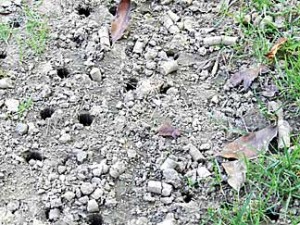
Spring is a good time to restore your lawn.
There is a way to do this successfully at a fairly low cost, and following this recipe just once will give you terrific results, but if you really want a healthy green weed-free lawn you’ll repeat this formula in both spring and fall for several years.
Remember this is a recipe, so skipping any step guarantees failure. I’ll give you the recipe first and then explain why it works so well.
First you’ll need to figure out how large your lawn is, in square feet. Multiply the width times the length of each section and add them together. Here are the ingredients, per 1000 square feet of lawn:

• 3oz Bonide Weed Beater Ultra (ready to spray hose-end sprayer)
• 5 lbs turf-type tall fescue grass seed blend (like Wetsel Class Act II)
• 6 lbs Espoma Organic 9-0-0 Lawn fertilizer
• 50 lbs pelletized lime
Here are the tools you’ll need: a walk-behind core aerator (“plugger”), a broadcast spreader, and a fireman’s style non-restrictive hose nozzle (like Gilmour’s Power Flow).
First, attach the hose-end weed killer dispenser to your garden hose and wet down the entire lawn.
Make sure no rain is expected for 24 hours, and the temperature is at least 45 degrees. Let it dry, and wait 2 weeks.
After two weeks, when the lawn is reasonably dry, spread the grass seed with the broadcast spreader. Hand seed in tight spots and along edges. Next, spread the fertilizer. Then spread the lime. Make sure you’re moving forward any time you open the shutter. If you’re not sure of your spreader settings, just set the opening fairly small and repeat your application (using a different pattern each time) until you’ve used up all your material. Sweep or blow all the extra material off the surrounding pavement onto the lawn.
Next, run the aerator over the lawn several times in different directions. Repeat more often in bare patches; your goal is to break up the soil as much as possible. The seed will find its way into the holes, where it will be protected from drying out.
In a week you’ll see the first new grass. Daily watering at this stage is critical. All you have to do is keep the soil most until your new grass is several inches tall.
A light watering each day should be enough. The easy way is to stand in the middle and spray the entire lawn with the fireman’s nozzle (a typical pistol-grip sprayer won’t put down enough water). On bare ground, putting down straw will help keep the soil moist.
Don’t mow until the new grass is six inches tall, and make sure your blade is newly sharpened. Set your mower at 4 inches (and leave it there from this point forward).
Here’s why this recipe works: the best defense against lawn weeds is healthy turf. Compacted soil is the enemy; weeds can grow there but lawn grass will struggle. Aeration penetrates and loosens the soil without damaging existing lawn grass. It makes “pockets” that collect moisture and shelter grass seedlings, capturing rainfall and preventing your seed and fertilizer from washing away. New grass can make a deep root system easily, protected from wind, sun and traffic. Core aeration is the “magic bullet” for healthy lawns.
Turf-type tall fescue makes an elegant dark green lawn that is drought tolerant and rugged. It is a fine-bladed, deep-rooted grass that spreads underground, forming clumps that fill in bare spots.
Turf-type tall fescue tolerates shade better than bluegrass or rye, and requires half as much fertilizer and water to look good. Using a blend hedges your bets against insects and diseases; over time the most rugged grass for your particular yard will crowd out the others.
Slow-release fertilizers work best for established lawns, where you want healthy turf and roots but don’t want the lawn to get shaggy and overgrown too quickly. For most lawns, lime is helpful and more lime is more helpful. Pelletized lime is easy to spread with a broadcast-type spreader.
You probably have broadleaf weeds like dandelion, spurge and plantain in your lawn. You can use the weed killer spray to selectively kill these right now, before you put down seed. Again, the best lawn weed control is healthy strong turfgrass.
Follow my recipe each spring and fall for a couple of years and you’ll have it. No amount of chemicals will really control lawn weeds if the lawn itself is sparse and weak. Scalping the lawn is a huge contributor to weed problems, since it allows sunlight to reach the soil surface and encourages weeds to sprout.
One last point: If you gather your grass clippings you are wasting a huge amount of money on fertilizer. The nitrogen in clippings is fertilizer you paid for, so use a mulching mower to recycle the clippings back into the soil.
Steve Boehme is the owner of GoodSeed Nursery & Landscape, located on Old State Route 32 three miles west of Peebles. To e-mail your landscaping questions click “Contact Us” from their website at www.goodseedfarm.com or call (937) 587-7021.
